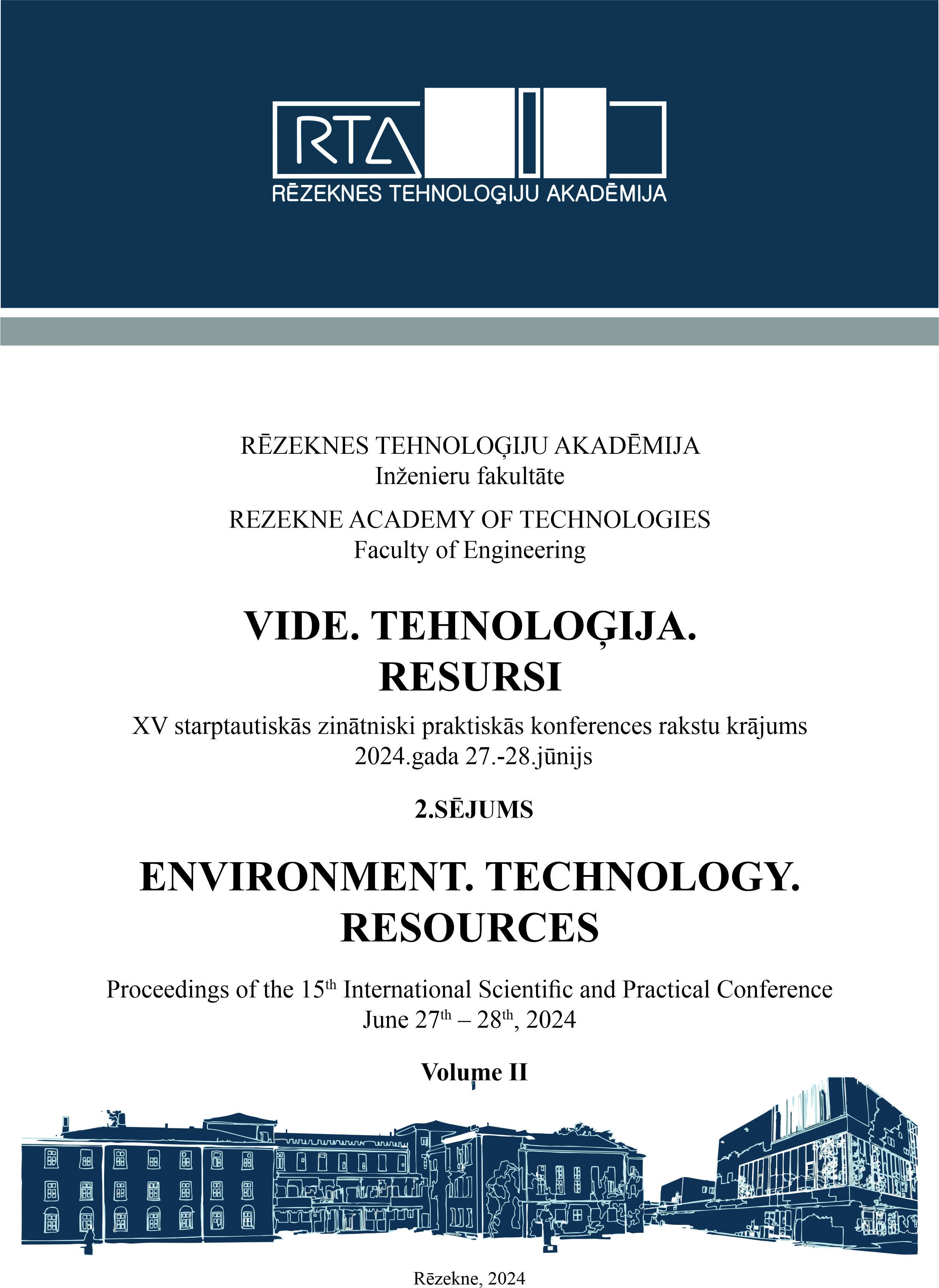CANVA PLATFORM: VISUAL CONTENT FOR DEVELOPING WRITING SKILLS OF PROSPECTIVE ENGINEERS IN ESP CLASSES
DOI:
https://doi.org/10.17770/etr2024vol2.8075Keywords:
Canva.com, enhanced learning, ESP classes, prospective engineers, visual content, writing skillsAbstract
This article explores the integration of visual content technologies, with a specific focus on the Canva.com platform, to enhance the teaching of English for specific purposes (ESP) to prospective engineers. The primary goal of the authors was to investigate the effectiveness and benefits of using Canva.com for developing writing skills among prospective engineers through a mix of theoretical research and practical implementation in an educational setting. For this purpose, they implemented targeted activities via Canva.com, provided classroom observations, conducted a literature review, and administered a questionnaire survey with 50 engineering students, which helped to analyze students' work and demonstrate the impact Canva had on the development of students' writing abilities. Canva’s user-friendly interface and visually appealing templates support the mastery of writing, covering various formats like resumes, cover letters, essays, and engineering blueprints. The article not only highlights the potential of Canva.com but goes further to present concrete examples of activities tailored for prospective engineers. Models of both individual visual storytelling and collaborative endeavours, exemplified by the “Evolution of Railway Technology” project, showcase the platform’s versatility in facilitating engaging and educational experiences. In addition to these activities, the authors provide insightful assessment criteria and teaching tips, offering valuable guidance on effectively incorporating Canva.com into the classroom. By seamlessly integrating visuals into writing activities, the authors emphasize the transformative impact on prospective engineers, encouraging them to express ideas more effectively and imaginatively. The Canva.com platform emerges as a dynamic and indispensable tool in ESP classes, cultivating an environment that not only stimulates creativity but also provides structured templates that empower students to navigate the intricacies of writing with confidence. Consequently, the article advocates wholeheartedly for the effective integration of Canva.com in English language instruction for prospective engineers, presenting a compelling avenue to elevate both their writing skills and overall language proficiency.
Downloads
References
W.-K. Chen, Linear Networks and Systems. Belmont, CA: Wadsworth, 1993, pp. 123-135. R. J. Blake, “Current trends in online language learning.” Annual Review of Applied Linguistics, vol. 31, 2011, pp. 19–35, https://doi.org/10.1017/S026719051100002X.
N. Dmitrenko, O. Voloshyna, S. Kizim, K. Mnyshenko and S. Nahorniak, “Smart Education in the Prospective Teachers’ Training.” CTE Workshop Proceedings of ACNS Conference on Cloud and Immersive Technologies in Education, vol. 10, 2023, pp. 38–53, https://doi.org/10.55056/cte.v10.
P. Gilakjani, N. B. Sabouri and A. Zabihniaemran, “What are the barriers in the use of computer technology in EFL instruction?” Review of European Studies, vol. 7(11), 2015, pp. 213– 221, https://doi.org/10.5539/res.v7n11p213.
D. N. Hidayat, J. Y. Lee, J. Mason, and T. Khaerudin, “Digital technology supporting English learning among Indonesian university students.” Research and Practice in Technology Enhanced Learning, vol. 17(1), 2022, pp. 23–27, https://doi.org/10.1186/s41039-022-00198-8.
M. Lailiyah and B. Y. Cahyono, “Indonesian EFL Teachers’ self-efficacy towards Technology Integration (SETI) and their use of technology in EFL teaching.” Studies in English Language Teaching, vol. 5(2), 2017, pp. 344–357, https://doi.org/10.22158/selt.v5n2p344.
X. Zhang, “Application of Cloud Computing Assisted Instruction in English Teaching.” Journal of Physics. Conference Series, vol. 1881(3), 2021, pp. 032025, https://doi.org/10.1088/1742-6596/1881/3/032025.
G. C. Zilka, I. D. Rahimi and R. Cohen, “Sense of Challenge, Threat, Self-Efficacy, and Motivation of Students Learning in Virtual and Blended Courses.” American Journal of Distance Education, vol. 33(1), 2019, pp. 2–15, https://doi.org/10.1080/08923647.2019.1554990.
K. Anwar, “The Perception of Using Technology Canva Application as a Media for English Teacher Creating Media Virtual Teaching and English Learning in Loei Thailand.” Journal of English Teaching, Literature, and Applied Linguistics, vol. 5(1), 2021, pp. 62–69, http://dx.doi.org/10.30587/jetlal.v5i1.2253.
F. Al Khoeri, W. Nuraini, R. Ramdani and S. Agum, “The implementation of Canvas to enhance English teaching and learning,” in: Proceedings International Conference on Education of Suryakancana, 2021, pp. 315–320, https://doi.org/10.35194/cp.v0i0.1366.
D. Rister and T. Bourdeau, “Collaborative Writing and Presenting: A course template for teaching students how to collaborate on communication projects across all classroom modalities.” Communication Teacher, vol. 1-7, 2021, pp. 345–351, https://doi.org/10.1080/17404622.2021.1889011.
T. N. Fitria, “Using Canva as media for English Language Teaching (ELT) in developing creativity for Informatics students’ ELT Echo.” The Journal of English Language Teaching in Foreign Language Context, vol. 7(1), 2022, pp. 58–68, https://doi.org/10.24235/eltecho.v7i1.10789.
N. L. Fauziyah, J. P. Widodo and S. N. Yappi, “The use of “Canva for Education” and the students’ perceptions of its effectiveness in the writing procedure text.” Budapest International Research and Critics Institute-Journal, vol. 5(1), 2016, pp. 6368–6377, https://doi.org/10.33258/birci.v5i1.4359 6368.
M. S. Hadi, L. Izzah and Q. Paulia, “Teaching writing through Canva application to enchance students’ writing performance.” Journal of Languages and Language Teaching, vol. 9(2), 2021, pp. 228–235, https://doi.org/10.33394/jollt.v%vi%i.3533.
M. Larasati and A. Rustandi, “Empowering student’s creative writing ability by using Canva (A case study research in one junior high school in Ciamis).” Journal of English Education Program, vol. 9(2), 2022, pp. 101–110, https://doi.org/10.25157/(jeep).v9i2.8548.
A. Yundayani, S. Susilawati and C. Chairunnisa, “Investigating the effect of Canva on students’ writing skills.” English Review: Journal of English Education, vol. 7(2), 2019, pp. 169–176, https://doi.org/10.25134/erjee.v7i2.1800.
J. Harmer, The Practice of English Language Teaching. Fourth Edition. England: Pearson Longman, 2001.
S. Melinia and N. Nugroho, “Creating a video using Canva application as an English learning media of recount text material.” Journal of English Education, vol. 2(2), 2022, pp. 118–129, https://doi.org/10.30998/jedu.v2i2.6644.
E. Nurhidayat, “Utilizing Canva As Digital Tools To Teach Grammar in Remote Learning Period.” Journal of English Language Learning, vol. 5(2), 2021, pp. 95–99, https://doi.org/10.31949/jell.v5i2.3413.
S. Santiana, D. Silvani and R. Ruslan, “Optimizing LMS CANVAS for interactive online learning perceived by the students.” Journal of English Education and Teaching, vol. 5(4), 2021, pp. 529–543, https://doi.org/10.33369/jeet.5.4.529-543.
S. Suhartono and I. Laraswati, “The use of visual media in teaching writing. English Education.” Journal of English Teaching and Research, vol. 1(1), 2016, pp. 45–49, https://doi.org/10.29407/jetar.v1i1.274.
Downloads
Published
Issue
Section
License
Copyright (c) 2024 Natalia Dmitrenko, Iryna Shkola, Bohdana Saliuk, Violetta Panchenko, Svitlana Neshko

This work is licensed under a Creative Commons Attribution 4.0 International License.


